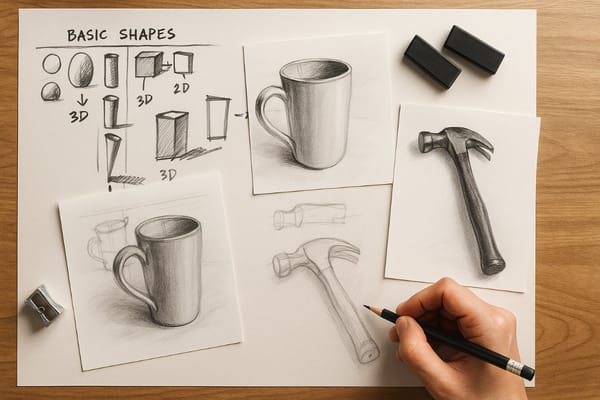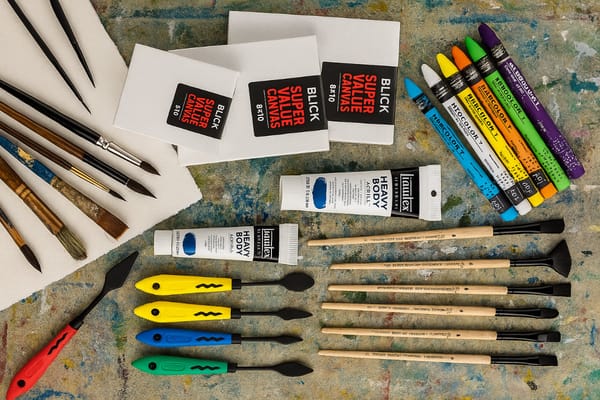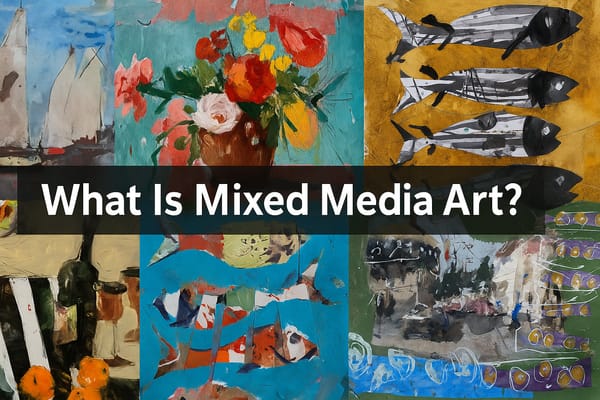Vibrant Watercolor World: Painting Primer for Newbies
Discover a beginner’s guide with techniques, tools, and tips for enchanting watercolor painting. The perfect start for your watercolor journey.
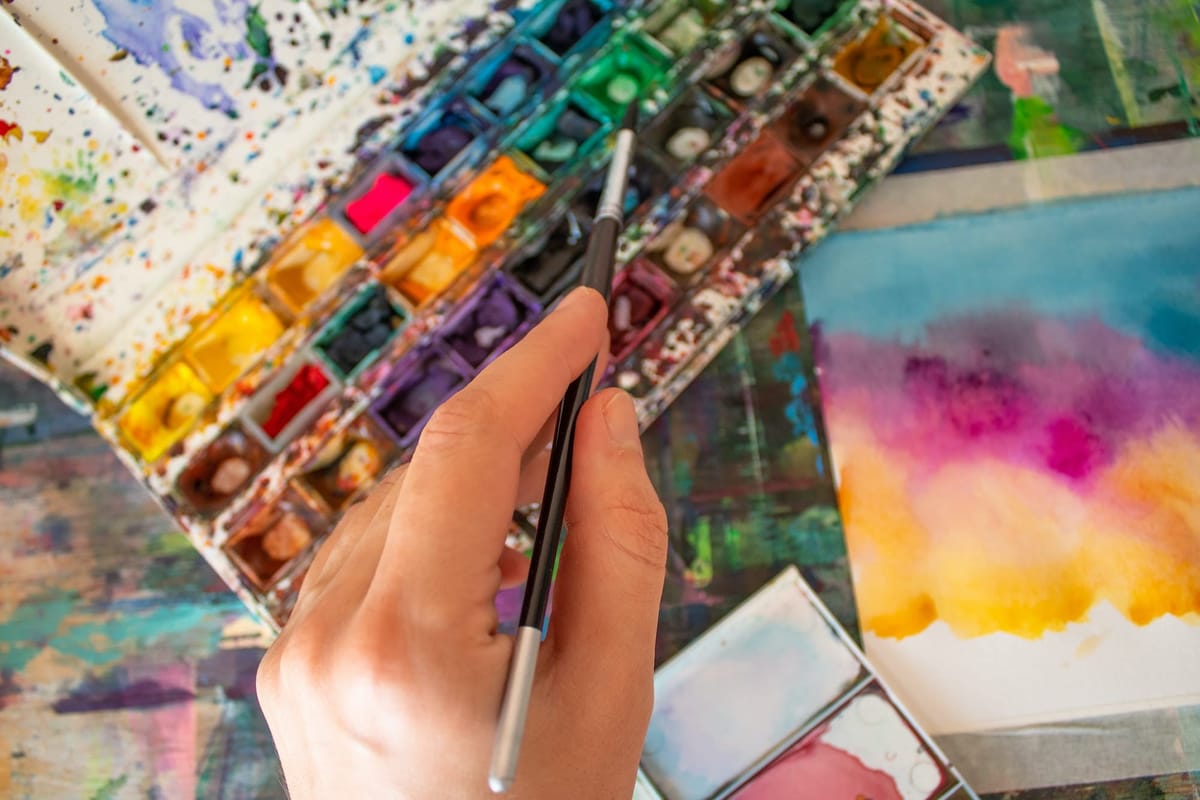
Created by Robert’s Watercolor Wonders: Your Gateway to Artistic Bliss! Discover an all-inclusive beginner’s guide with techniques, tools, and mastery tips for enchanting watercolor painting. Embark on captivating projects that unlock the secrets to creating mesmerizing art. Delve into our free resourceful website, crafted by a devoted artist, ensuring unrestricted enjoyment in your learning journey.
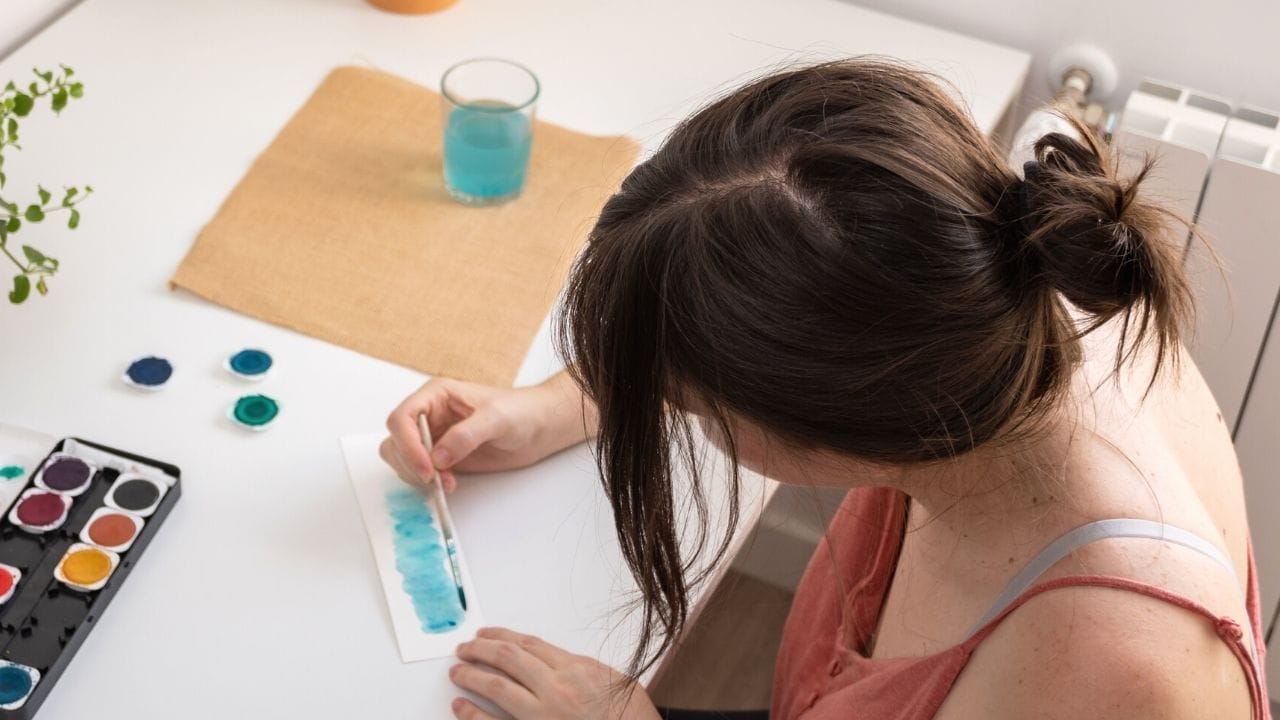
Brush, Splash, Awaken: Unveiling the Magic of Watercolors for Beginners
It’s time to get schooled in their captivating characteristics, conquer crafty techniques, dance with gravity and fusion, unlock color mixing secrets, decode watercolor paper mysteries, and embrace the enchanting world of color theory. Brace for four thrilling projects that ignite your skills and showcase your newfound brilliance!
Let’s start with watercolor materials
Watercolor wonders await, with a palette of essentials to ignite your creativity! Gather the elemental ingredients: vibrant watercolor paints, a canvas of watercolor paper, trusty brushes, a painter’s palette, and an array of handy accomplices like paper towels, water reservoirs, and even a trusty blow dryer to accelerate drying time. These cherished materials are recommended not only for beginners but also for seasoned artists, ensuring a masterpiece awaits at every stroke.
Watercolor Paints and Colors (I use Holbein brand)
- Yellow ochre – warm yellow
- Cadmium yellow lemon – cool yellow
- Ultramarine blue – warm blue
- Cerulean blue – cool blue
- Alizarin crimson – cool red
- Cadmium red light – warm red
- Neutrals – Burnt sienna, raw umber and neutral tint
Watercolor Brushes
- Silver black velvet jumbo large/medium
- Princeton Neptune pointed round #12 – Excellent for most details
- Princeton Neptune pointed round #6 – Ideal for smaller spaces and details
- Princeton Neptune dagger 1/2” and/or 3/8″ – Awesome for creating interesting brushwork
- Escoda Castagnet needle brush
Watercolor Paper
- Fabriano Artistico 140 lb. cold press, bright white
- Saunders Waterford 140 lb cold press, bright white
Miscellaneous
Gator-foam board, watercolor palette, masking tape, two water reservoirs, paper towels and finally, the last watercolor supply is dish rags
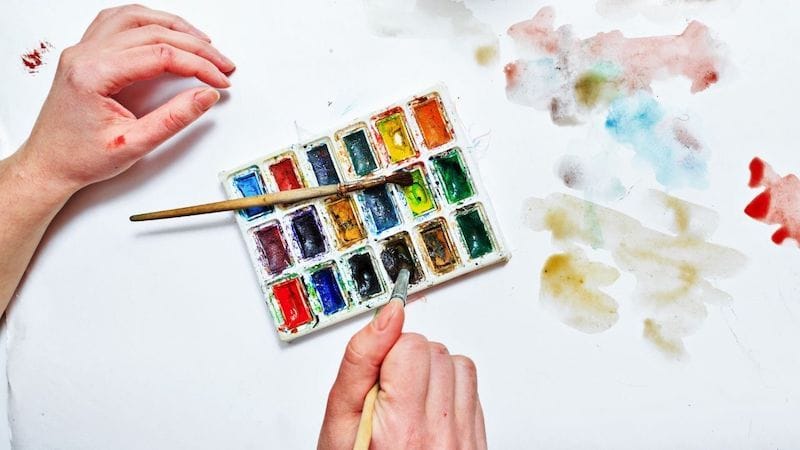
Unlock the Secrets: Unveiling the Six Watercolor Characteristics for Artistic Growth
Prepare for an enlightening adventure as we dissect the newbie skills laid out in this side-splitting article. These quirky characteristics transcend genres, whether you’re painting majestic landscapes, blossoming flowers, or even hilarious portraits. They are the bedrock of watercolor wizardry, so cozy up to them and embrace their magical might.
As we journey through this tutorial, let’s keep it delightfully simple. Sure, this might not be your first rodeo, and we all secretly yearn to paint an awe-inspiring watercolor wonderland. But trust me, my dear novice, many beginners stumble when they gallop ahead.
Beware the perilous path of rushing towards the perfect finished art—it’s a gargantuan blunder! Instead, let’s embrace playfulness, doodling, and good ol’ fashioned fun in the process of learning. Unleash your relaxed state of mind and watch the pressure vanish like a magician’s trick!
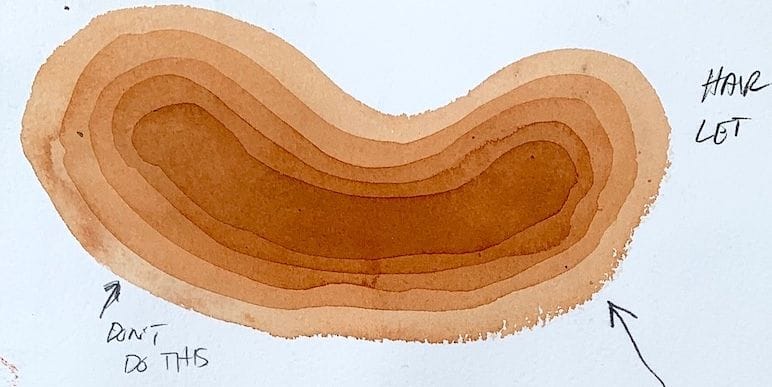
#1 – Transparency, the Backbone of Watercolors
Watercolor is a transparent medium. It’s all about thin paint and how it interacts with watercolor paper. Watercolors are water-soluble – meaning when you add plain water to any of the colors on your palette, they thin out and become translucent.
Watercolors can be thinned further by adding more water or even mediums like glazing liquid or gum arabic. Watercolor pigments do not provide cover like acrylic. When using thin coats of paint (transparent) they will brush on and look light and wispy and if too much is applied in one go, it will dilute its appearance – so try to think in terms of the watercolor pigments’ transparency.
However, all is not lost! Watercolors are forgiving because they can be layered on top of each other – with some water added to the mix, they will blend very easily. With practice, you will begin to see how many different colors you can create by mixing your unique colors from a given palette. Watercolour painting is very much about experimenting with paint, mediums, and paper to get results that make sense for each individual.
To get the best transparent results follow these steps;
- When you paint the first shape in the transparent layers study above, be sure to start on dry paper.
- Use a very weak, tea-like mixture.
- Be sure to pre-mix more than you think is needed. Many artists, including me, run out too soon.
- Allow each layer to dry completely before adding the next one on top.
- Start painting the shape bigger than you think you need, or you will run out of room to add more layers.
This project is perfect for practicing watercolors and you’ll learn an important skill that will be used throughout your watercolor painting endeavors.
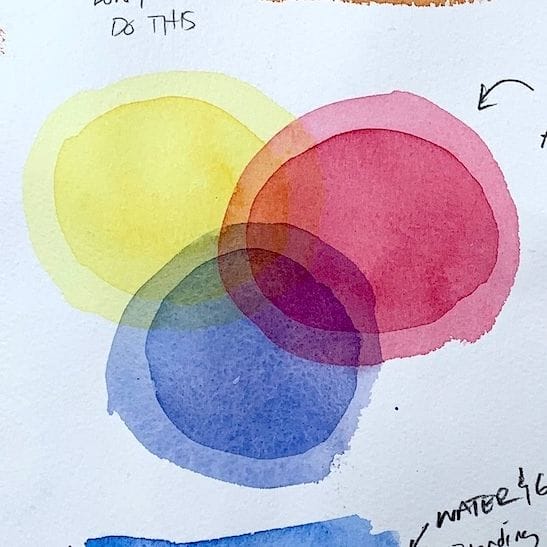
#2 – Master Watercolor Layering with Wet-in-Dry Technique
Prepare for the enchanting transformation when two or more hues intertwine, giving birth to captivating secondary colors. Witness the mesmerizing alchemy as these colors merge and birth an entirely new palette.
With watercolors’ translucent nature, they crave multiple layers, allowing each stroke to dry before embracing the next. Brace yourself for the wondrous dance of colors that only patience and layering can unveil.
Embark on a creative voyage as we unveil the step-by-step tutorial
- Begin with a dry canvas, meticulously pre-mix your chosen hue, and delicately apply the moistened paint to the paper, painting the very first circle.
- Keep in mind, dear artist, to gracefully let the paint settle on the canvas, resisting the urge to fuss and meddle.
- Remember, the more we revisit a wash, the higher the odds of unraveling its magic.
- So, let’s embrace the art of restraint and witness masterpieces unfurl before our eyes.
- Allow each circle to dry completely before adding another one.
- I recommend using cold press paper over hot press, or a slick surface. This will help you achieve that grainy look that makes watercolor so unique.
Embrace Your Colorful Freedom: Let Your Imagination Run Wild!
Remember, dear artist, the realm of colors is yours to explore! While I opted for the primaries, reminiscent of a vibrant color chart wheel, feel free to unleash your creativity and substitute hues as you please. Just ensure that you choose three distinct watercolor shades to maintain the magic. So, if you have a penchant for bold and vibrant colors, don’t hold back! Embrace the brilliance and let your artwork shine in a dazzling symphony of hues!
Unveil the Dance of Layers: Watch Colors Transform!
With each stroke, paint the second circles slightly smaller, leaving a delicate ring along the outer edge. Take a moment to observe the captivating metamorphosis as one color gracefully embraces another. Marvel at the mesmerizing magic on the left side of the study, where the vibrant yellow transcends into a lush green when layered over the serene blue. Behold, dear artist, the enchanting phenomenon of transparency at play, weaving wonders with every brushstroke!
Amidst the pursuit of realism, many beginners tend to overlook this mesmerizing trait of watercolors. But fear not, my artistic friend! Let’s simplify our approach and allow the medium to showcase its true prowess. Release the burden of hyper-realism and let the watercolors work their enchantment. Trust in their innate abilities, and prepare to witness the extraordinary unfold with every graceful stroke.
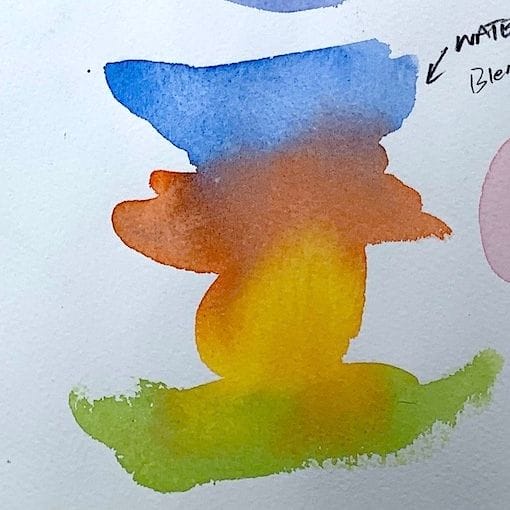
#3 – Harness the Power of Gravity & Fusion: Elevate Your Watercolor Mastery
Embark on a gravity-defying adventure to unlock the full potential of watercolors! When indulging in this artistic realm, it’s best to tilt your paper, or board, letting the paper take the lead. This simple act prevents unsightly water puddles from forming randomly or dripping down to the bottom. Moreover, tilting facilitates the delightful fusion of moistened colors, allowing them to bleed and blend harmoniously.
Remember, a good-quality watercolor paper boasts resilience against excessive buckling, yet tilting remains a valuable ally against unwarranted water pooling. Embrace the magical dance of colors, their carefree intermingling, and the organic charm that ensues. But heed this cautionary note: resist the urge to revisit wet washes, for they possess the potential to sabotage your masterpiece.
If you find yourself smitten by this whimsical, unrestrained allure, delve into numerous gravity & fusion experiments. Embrace a vibrant array of hues—bright and lively, subdued grays, earthy tones, and beyond. Let your imagination soar and watch as gravity and fusion become your greatest artistic accomplices!
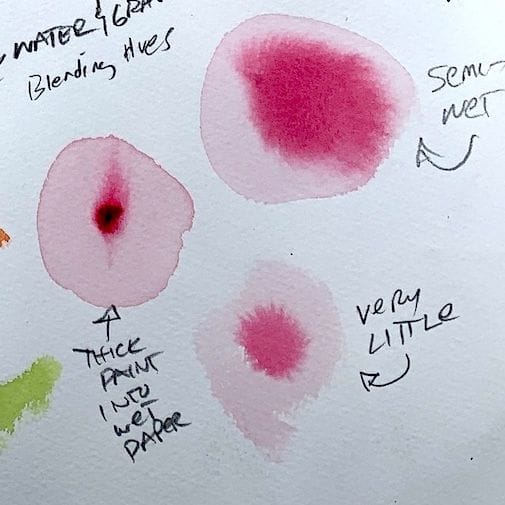
#4 – Learn To Manipulate Paint Thickness & Wet-in-Wet Washes
As you venture onto the mystical realm of wet watercolor paper, a crucial tidbit awaits your discovery. Thicker paint, dear artist, resists dissolving to the same extent as its thinner counterparts. Why, you ask? Watercolors boast an exquisite composition of fine light-reflecting pigments, their surfaces sprawling magnificently, beckoning the touch of water and dissolving into a magical solution. This captivating alchemy, known as pigment dispersion, breathes life into our artwork.
Many beginners find solace in working solely with a single paint consistency. However, as you traverse the realm of experience, you shall unlock the hidden marvels that lie within thicker paint. Embrace its undeniable utility, and watch as your artistic prowess reaches new heights, guided by the playful whispers of the watercolor world.
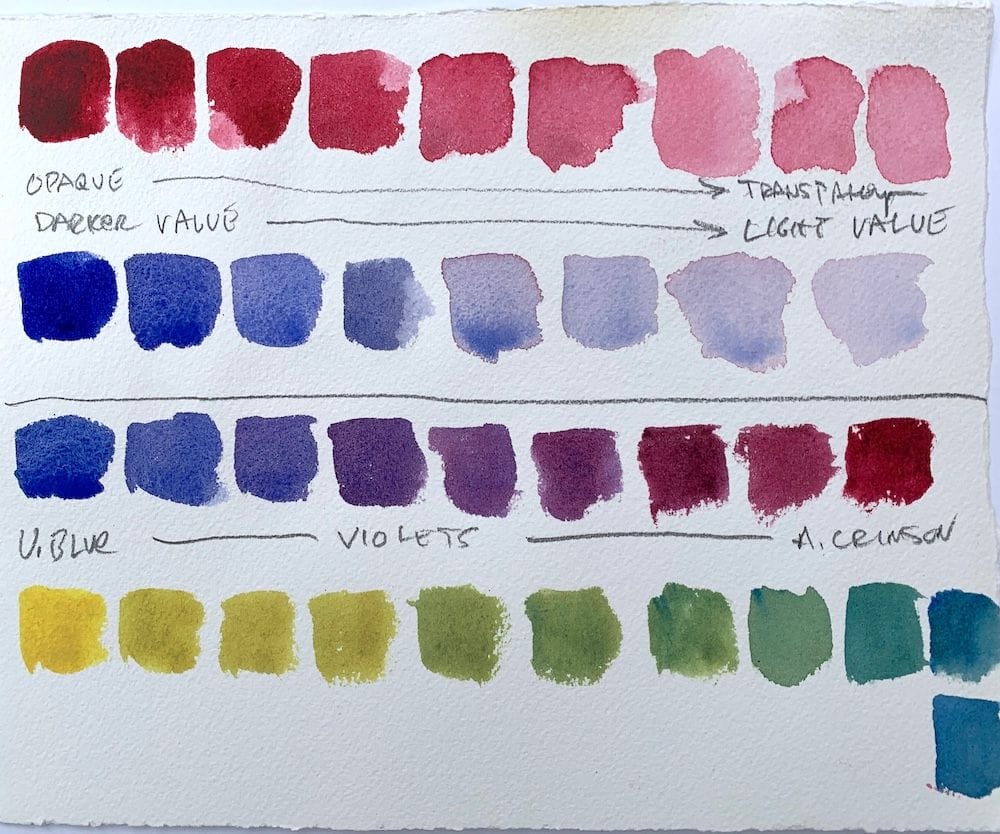
#5 – Understand the Power of Color Charts: Master Values & Hue Transitions with Ease
Embark on an artistic journey of discovery through the realm of color charts! These invaluable tools will pave the way for your understanding of values and the graceful transitions of hues.
Embrace the magic of organized color exploration as you create these charts, unlocking a wealth of knowledge and enhancing your artistic prowess. Prepare to witness the transformative impact they have on your artistic journey!
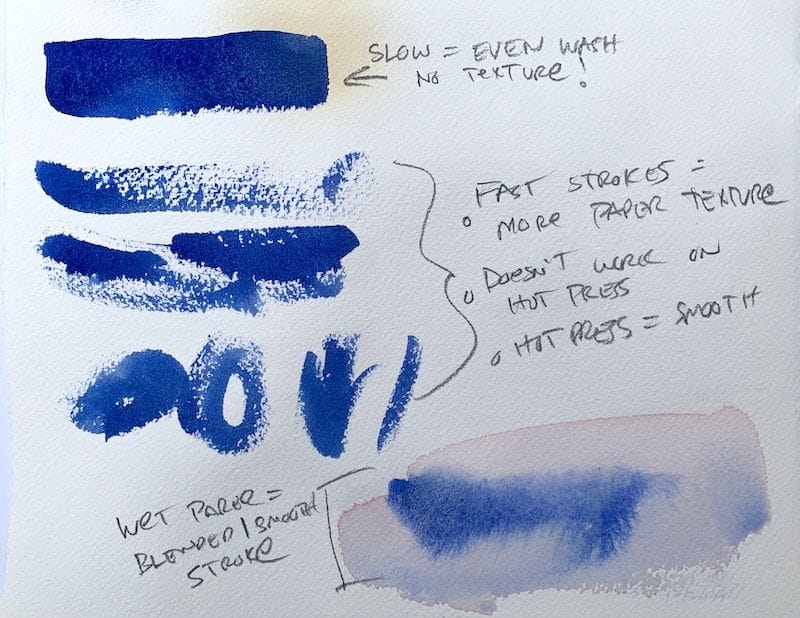
#6 – Use Brush Tempo: Mastering Watercolor Brushstrokes for Beginners
The speed at which you wield your brushes holds great significance in the realm of watercolor painting. It determines the revelation of paper texture—the slower the stroke, the more coverage; the faster the stroke, the gleaming white valleys.
To explore this technique, indulge in playful experimentation on a blank canvas or utilize scrap watercolor paper. Unearth forgotten rejects from drawers or unburied treasures from sketchbooks. Observe how wet paper hampers the effectiveness of swift strokes, while semi-wet or dry surfaces prove to be the perfect canvas for your artistic wizardry.
Let the Beginner Adventures Begin with Three Simple Projects
Now is the perfect moment to embark on exciting projects as a budding artist! Dive into the world of watercolor painting, testing your skills and embracing the thrill of creation. And here’s a delightful bonus: when you master these projects, they transform into magnificent artworks, worthy of display in any studio. Remember, there’s no need to feel intimidated!
The path to becoming a skilled watercolor artist is paved with mistakes, as this imperfect medium invites playful experimentation. So, have a blast, surrender to the whims of the paint from time to time, and don’t forget to explore the plethora of watercolor ideas available on this website. Let your creativity soar as you embark on these adventures and discover even more captivating projects along the way!
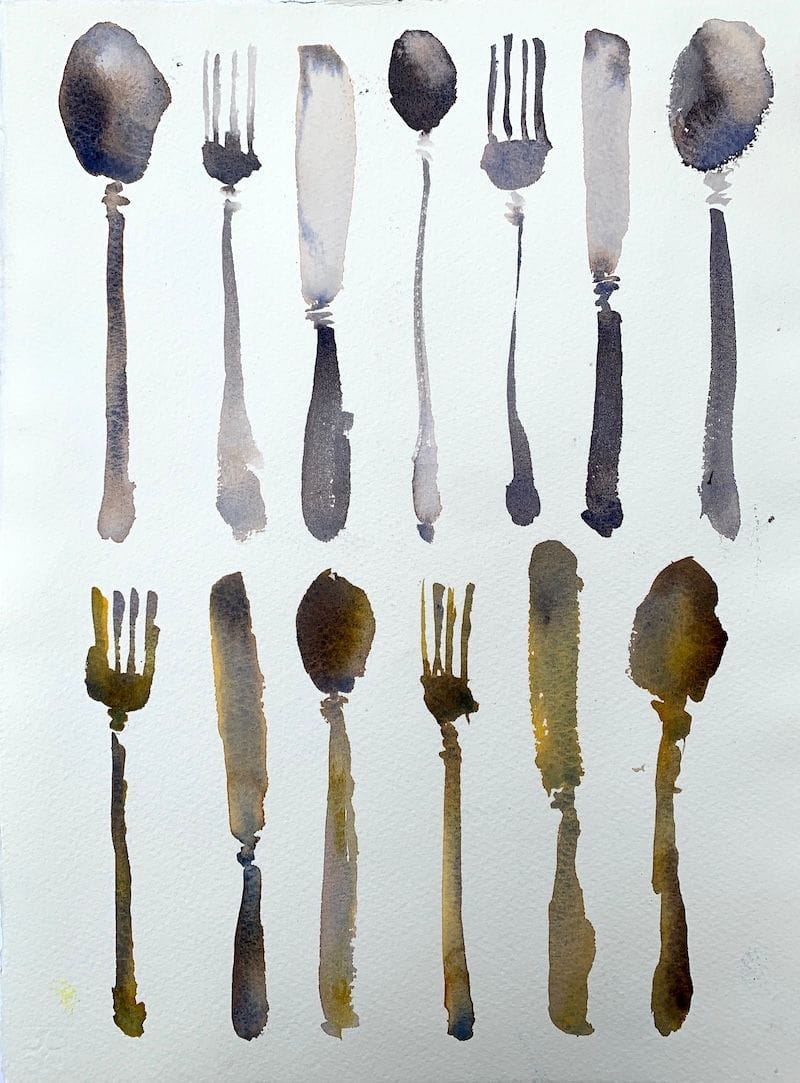
#1 – Embrace the Simplicity: Try Painting Silverware
Begin your artistic journey with a delightful simplicity—the enchanting subject of silverware. This minimalistic project serves as the perfect playground for honing your beginner skills. Even though it may appear modest, don’t skimp on quality watercolor supplies. Embrace the contemporary watercolor techniques that add a touch of elegance and intrigue to your artwork.
Explore the realm of thin and thick paint, the dance between slow and fast strokes, the art of lifting wet pigments, and so much more. Remember, dear artist, there’s no need to overcomplicate the learning process. Embrace the joyous exploration of watercolor art.
Once again, follow the gradual progression from light to dark values as you layer your colors. This wet-in-wet technique demands your attention—avoid letting the layers dry completely, for it is in their interaction that the true magic unfolds.
When executed with finesse, this experience promises a delightful watercolor journey, resulting in a marvelous masterpiece. Hang it proudly in your kitchen or grace your fridge with its artistic allure.
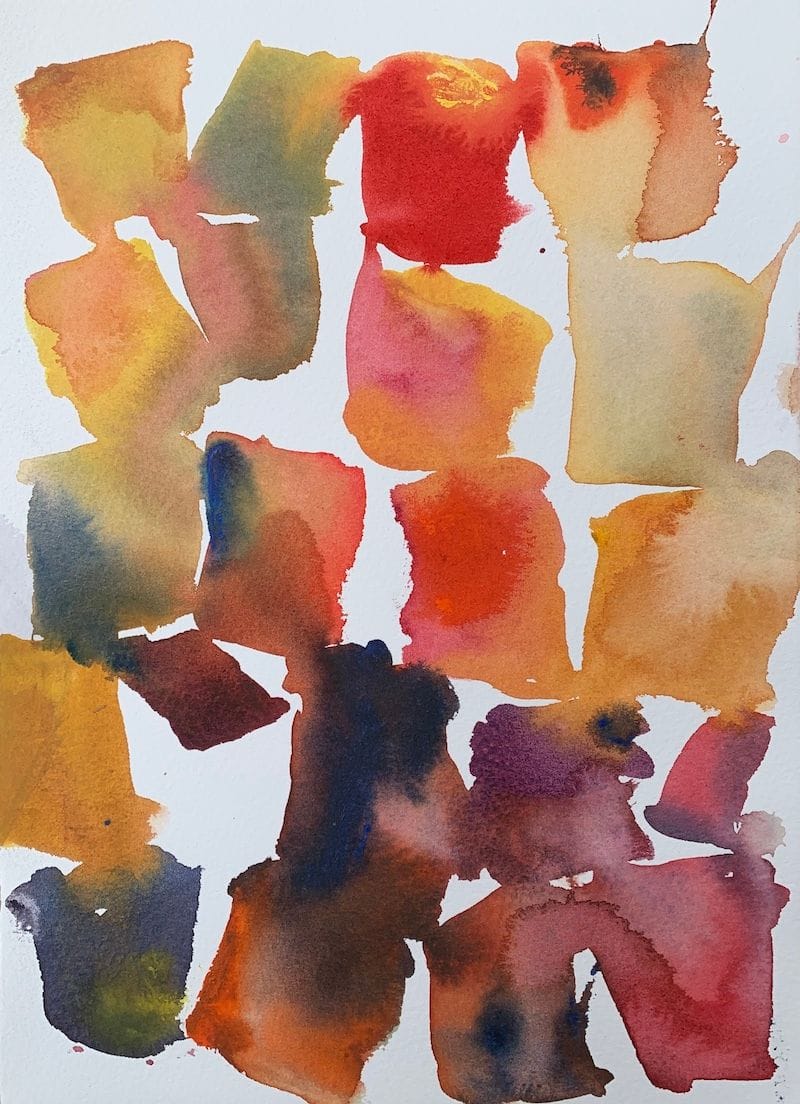
#2 – Unlock the Abstract Squares Adventure: Embrace Watercolor’s Creative Whispers
Step into the realm of abstract squares, a captivating project designed to unlock the secrets of gravity and fusion, as well as the mesmerizing art of color mixing. As you embark on this artistic journey, you’ll discover the joy of creating a super awesome watercolor painting for your home! This project serves as a gentle reminder of the wonders that unfold when we allow watercolor to guide us, stepping aside from our preconceived notions. Embrace it as an artistic testament, a celebration of what watercolor truly desires to accomplish.
But that’s not all! This project showcases just one of the many modern watercolor techniques at your disposal. Feel free to scale up your creativity, crafting a stunning piece of art that adorns your cherished abode. Unleash your inner explorer, for in this adventure, anything goes! Embrace the vast array of watercolor paints and watercolor brushes, as you dance hand-in-hand with the whimsical nature of this captivating medium. Let your imagination soar and revel in the beauty that emerges on your canvas!
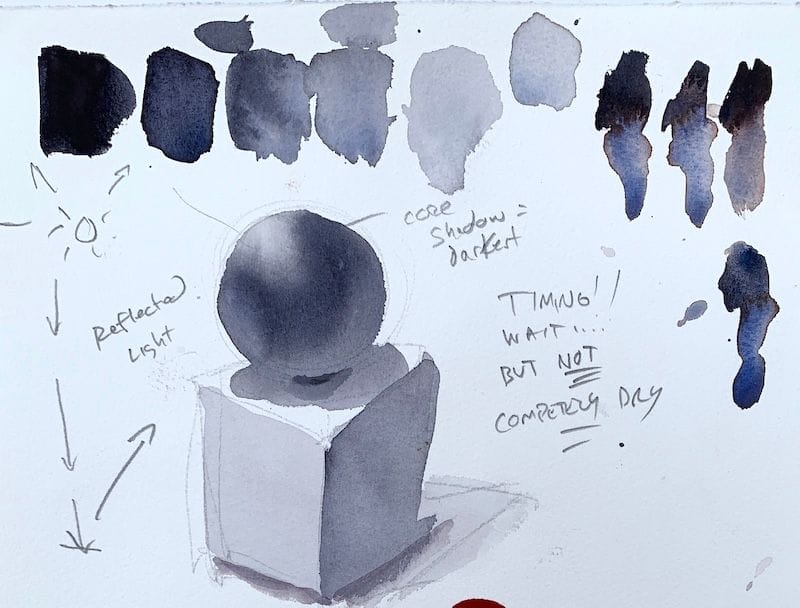
#3 – Illuminate the World with the “Light on Form” Project
Prepare for a challenge that promises monumental rewards—immersing yourself in the mesmerizing world of light on form. This endeavor demands precision in values, impeccable timing, and masterful brushwork. Yet, the payoff that awaits is nothing short of extraordinary if executed with finesse. To embark on this artistic adventure, equip yourself with gray watercolor paint and create a simple chart—a visual companion that guides you in selecting the perfect values for your watercolor paper.
Patience is key in this pursuit of excellence. Embrace the understanding that mastering this technique may require multiple attempts. Begin with gentle strokes of light values and gradually delve into the depths of darkness with each layer. Allow the paper to dry completely before adding another, testing your patience along the way. As you paint the sphere, let your brushstrokes dance in a circular motion, infusing it with a captivating roundness.
And here’s a secret weapon: while the paint is still wet, employ a clean, damp brush to delicately lift the highlight, adding an extra touch of brilliance to your creation. Embrace the journey of honing this technique, for it unveils the true essence of patience and artistic growth. Let the light guide you as you breathe life into your masterpiece!
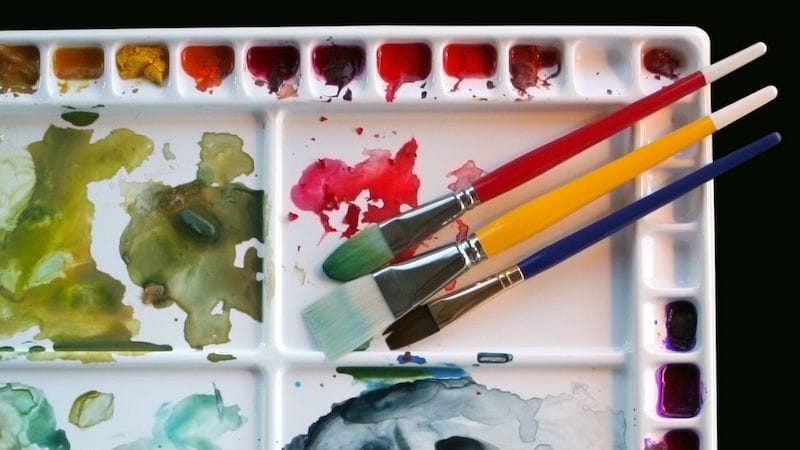
Unveil Your Inner Artistic Warrior: Overcoming Beginner Hurdles
Did you know? The path of a beginner artist is often strewn with obstacles, causing many to abandon their artistic aspirations within the first few months. It’s easy to feel frustrated and contemplate giving up—it’s simply part of the journey. But fear not! I’m well acquainted with the pitfalls you might encounter, and I have some valuable advice that transformed my painting skills in less than a year!
- First and foremost, resist the temptation to create finished masterpieces right from the start. Falling into this trap will only breed disappointment and frustration. Instead, embrace the realm of studies, doodles, and playtime. This shift in mindset will revolutionize your attitude, fostering an environment of exploration and boundless creativity.
- Remember, start small! Monumental paintings will have their time, but for now, seize the opportunity to work with quarter sheets of watercolor paper (9″ x 12″ or 11″ x 14″). Embrace the joy of new watercolor ideas and don’t shy away from utilizing both sides of the paper. Let your creativity flow freely until every inch is adorned with your artistic expression.
- To make progress, focus on one aspect at a time. Jot down three challenges you currently face and dedicate your practice sessions to honing each one relentlessly. You’ll be amazed at how quickly your skills improve when you approach your art with intent!
Always remember, watercolor is an imperfect medium. It doesn’t demand control at every turn. Release the need to fuss over every minute detail and instead, embrace the enchanting beauty of imperfections. Become an unwavering enthusiast, defying the odds and shattering the stigma of quitting. I have full confidence in your ability to embrace this artistic journey and triumph!


